Acoustic Instrument
Primers
What Kind of Guitar
Should I Start On?
What Kind of Banjo
Do I Want?
Evaluating and
Buying Used
Guitars
Setting Up
Fretted Instruments Whatever Happened
to the Banjo?
Beginning Five-
String Banjo
6-String Banjos
Banjo Pickups
Axes in my Life
What is a
Bluegrass Banjo?
Dean "Backwoods
Six" Shootout
Music Theory
Primers
Introduction
to Scales
Introduction
to Chords
Circle of Fifths
Other Articles
About Music
How to Give
Guitar Lessons
Musician or
Wannabe? Did God Really
Give Rock &
Roll to You?
Are You a
"Brand Bigot"?
Who Owns Folk Songs?
Historical Links
About the
National Road
The Story Behind
the Story - Real
People, Places,
and Events
About the Play
Play Home
What's New
Overview
About the
Music
About the
History
About the
Logistics
About the
Cast
Synopsis
About the
Set
About the
Author
Contact Us
Home

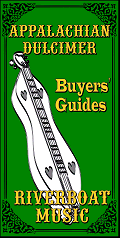
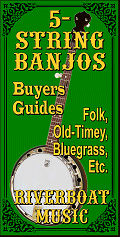

|

|
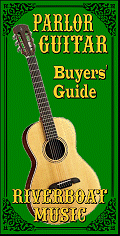
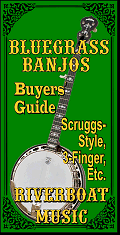

Beginning Five-String Folk Banjo - Part 11 - Other Keys and Tunings
| Written by Paul Race for Creek Don't RiseTM and School Of The RockTM |
This is a follow-up to our article on Standard ("C," DBGCg)) and Raised Fifth (DBGDa) banjo tunings, which hopefully helped you begin exploring the world outside of G tuning.
Back when I was a youngster, banjo pickers played all kinds of music. Even "folk" acts like the Limeliters often performed songs they liked from obscure pop and musical theater sources. And "folk" was more like what we call "World Music," today, with Latin, African, Middle Eastern, and Eastern songs and tropes being added to the mix. In pop orchestras, the guitar player was expected to be able to double on banjo. Although he or she usually chose a four- or six-string banjo, the 5-string occasionally made an appearance.
In other words, the well-prepared, working 5-string player might find himself accompanying "Salty Dog" in one gig, "Tzena" in another, "Malaguena" in another, "Hava Nagila" in another, and "Somewhere Over the Rainbow" in another. Not only did the picker find himself or herself encountering funky chords in the middle of a score of otherwise "normal" chords, the picker might be asked to play the whole song in Ab or some such.
Guitarists have relatively little problems with "obscure" keys.
5-string players, on the other hand, have to contend with the drone string whenever changing keys.
A capo is a device that fastens to the neck of a guitar, banjo, etc, and frets all the strings at the same time (except the drone string on a 5-string banjo). This essentially "changes the key" of the instrument, so the player can play the song in, say Bb, while using the chords from the key of G. This can get interesting if you're reading music you don't already know very well - that's another place your "Circle Of Fifths" training comes in. But guitarists do it all the time.
In my experience, guitar players are not intrinsically smarter than banjo players. So why don't more banjo players do this? Because they get confused about what to do with the fifth string. There are hardware mods you can do, but there are also a lot of things you can do without getting getting out the drill press or sending your baby off for service.
The basic principle is that for most songs, the fifth string has to be tuned to either the tonic or the fifth of the scale that the song was in. You're already doing this in the keys we've practiced so far:
Right there, that gives you the ability to play in the four most common Folk/Country/Pop keys without ever getting too complicated.
By now, you may be wondering if tuning your fifth string up and down all the time will make it crazy and old before its time. The answer is that it may have some effect. That said, if you don't go higher than A, by the time the extra tuning causes your fifth string to break, it's probably time to change the set anyway. In my case, I tend to use .009 or .010 strings on the fifth string, and I'd estimate that I can crank the fifth string up and back between G and A a couple hundred times before they pop. I also keep extra strings onhand, and you should, too, regardless of whether you ever retune your fifth string.
Eb and Bb are tricky, because you can put a capo on the third fret and play in C or G, respectively, but you pretty much have to tune the fifth string up to Bb, and some strings on some banjos don't like going up to Bb very much. E is worse, because you either have to
This section wouldn't be complete without a table giving you some suggestions for using a capo and retuned fifth string to play in funky keys. Again, as long as you never get out of certain circles, you'll probably never need to do most of these, but on the off chance that you're invited to play banjo for a concert or a church "special" and you learn that the diva, er, singer, insists on a funky key, here it is. Again, these are only suggestions, and a few aren't entirely satisfactory, but they may get you out of a jam:
Using a Capo to Play Goofy Keys
This Key: | ||||
or DBGC (C Tuning) | ||||
(if you're much better at C tuning than D) | ||||
(if you want to solo or play blues licks) | ||||
(works for accompaniment or simple solos) | ||||
(or B if you like to live dangerously) | ||||
(or Bb if you like to live dangerously) | ||||
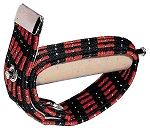
By the way, if you don't already have a capo yet, let me recommend a cheap Jim Dunlop elastic capo. Not because it's better than the fancy clip on ones, but because it does the job, and you can keep it on your banjo strap so you always have it handy. And if you leave it on a music stand somewhere, you're not out serious bucks. You can also afford one for each banjo or guitar you own, so you never get into the bind of showing up for a gig without it. (If you buy one for a guitar, get the upgrade that has two elastic straps instead of one.)
Note: While this approach works for accompanying songs in every key, a few solos that require you to play "up the neck" depend on the first and fifth strings producing the same note if you fret them on frets six and higher.
Practice This NOW - Before you move on to the next parts of this "lesson," which are mostly for educational purposes anyway, please practice playing some of your favorite banjo parts in goofy keys. You could start with "Boil that Cabbage Down," which you've been playing in G. Put your capo at the second fret, and tune the fifth string up to an A. (It should be the same pitch, unfretted, as the first string is when you fret it at the seventh fret). Let her rip. Then try every other song you know in G. Piece of cake, right?
Banjo Mods to Make Playing in Unusual Keys Easier
The most common modifications revolve around making it easier to "capo" the fifth string and using longer necks.5th-String Capo
Banjo pickers who play with folks used to playing in weird keys have tried a number of ways to retune the fifth string quickly. The fifth-string capo is one way to accomplish this.
Fifth String Capo - You don't see this as often as you used to because is a semi-permanent installation, it clutters up the look of the banjo and some folks think it makes it harder to play further up the neck. But I'm going to describe it because you do see on occasion.
The photo below hows a Shubb unit, which has a thumb screw to tighten the mini-capo in place. Others have springs, and a few simply slide between the string and the fret to act a a sort of movable "nut."

The most common 5th string capo design consists of a metal rail that attaches to the neck and a spring-loaded or screw-tightened device that can slide up and down on it. In its "neutral" position, the device rides between the fifth fret and the nut, so it has no effect. But if you want to go from G to A in a hurry, you just slide the thing out of neutral position set it so that it frets the fifth string at the seventh fret.
Advantages
- It's relatively easy to install, though I wouldn't put it on an expensive banjo unless I tried one on someone else's banjo first or was a craftsperson.
- It automatically gives you chromatic pitches so you can fret it at Bb, B, C, C#, and D. This makes changing to wierd keys faster. If the song is going to be in A and go to Bb, you can put the fifth-string capo at the seventh fret and your "real" capo on the second fret and play in G. Then when it comes time to go to Bb, you slide them both up a fret (takes about a beat) and keep going. No, this never happens in traditional Bluegrass, but it happens in Country and in Bluegrass-inspired pop arrangements from time to time.
- It keeps the 5-string tuned the same a the 1st string on the higher frets, which is useful for certain solos and rolls.
Disadvantages - It's relatively expensive and will leave screw holes if you take it off. I go back and forth among different banjos a lot, and equipping them all would run into real money. Plus, I think it clutter up the look a little.
Using in Conjunction with Capo - A fifth-string capo works in conjunction with a "regular" capo - it doesn't replace it. The table below (which looks a lot like the table above, tells you which fret to put the capos on to play in every key.
Location | This Key: | |||
or DBGC (C Tuning) | ||||
(if you're much better at C tuning than D) | ||||
(if you want to solo or play blues licks) | ||||
(works for accompaniment or simple solos) | ||||
Tune down 1/2 step unless your 5th-string capo goes up to the 11th fret (C#) | ||||
Tune down 1 step unless your 5th-string capo goes up to the 10th fret (C) | ||||
Spiking the Neck
This is actually a more primitive technology than the 5th string capo, but it is more convenient for many people. It involves taking "rail spikes" from HO trains and making one or more permanent mini-capos right on the neck of the banjo. It you have the skills (and preferably a drill press) to do it yourself, it costs almost nothing - a pack of a hundred costs a few dollars.On the other hand, if you're a clutz or you have a priceless heirloom, you may want to pay someone else to do it. The last time I tried to get a price, a local fellow said he would do it for $40 a spike. Ouch.
 The principle is simple. An HO rail spike is about the size and shape of a paper staple leg with about 1/8" of the crosspiece stiill attached. The craftsperson uses a carefully held, very tiny drill to drill one or more tiny holes into the fingerboard along the path of the fifth string. Then, a tiny drop of glue may be applied, and the spike is poked or otherwise encouraged into the hole, with the little crosspiece facing perpendicular to the string. (Some folks face them "up," and some folks face them "down." Both factions insist they're doing it the "only right way.") It goes in deep enough so that when you hook the 5th string under the part that is sticking out, it will hold the string against the fret.
The principle is simple. An HO rail spike is about the size and shape of a paper staple leg with about 1/8" of the crosspiece stiill attached. The craftsperson uses a carefully held, very tiny drill to drill one or more tiny holes into the fingerboard along the path of the fifth string. Then, a tiny drop of glue may be applied, and the spike is poked or otherwise encouraged into the hole, with the little crosspiece facing perpendicular to the string. (Some folks face them "up," and some folks face them "down." Both factions insist they're doing it the "only right way.") It goes in deep enough so that when you hook the 5th string under the part that is sticking out, it will hold the string against the fret.

There are dozens of "instructions" on the internet. My major recommendations would include trying your setup on a block of wood first, so you know you have the right sized drill bit and can get the correct angle.
Where to spike? If you look at the 5th-string capo chart above, you'll see that putting spikes at the seventh and ninth fret will allow you to play in C, G, D, A, and E, all the common Folk, traditional, Buegrass, and Country keys. If you just use a 2-spike setup, and someone insists you play a song in a wierd key like Bb, you can always use the capo, then retun the string a step up or down.
On the other hand, if you at spikes at the 8th and 10th fret, you can play in almost every key you're ever likely to play in without retuning at all. So some folks do them almost chromatically, which gives them the same split-second flexibility as you get with a 5th-string capo.
Advantages
- Very inexpensive if you have the skills and tools to do it yourself.
- Much faster than retuning the 5th string when you need to change keys.
Disadvantages
- If you aren't especially good at this sort of thing, you run a risk of:
- Splitting the fingerboard
- Leaving them too high so they just cause fret buzz instead of fretting the string.
- Placing them too close to the axis of the fifth string, so the fifth string buzzes on the to of them when they're not in use.
- Placing them too far from the axis of the fifth string, so you wind up stretching the string significantly out of tune when you notch the string under them.
- Drilling or poking the pointy end of the spike out through the back of the neck.
- If you pay someone to do it, you have to make certain they know what they're doing. Most "luthiers" don't. You may also wind up paying real money if you want to do more than a couple spikes. Where I live only one guy does this and he charges $40 a spike!
- If your banjo is worth more to you as a collector's item than a gigging instrument, you'll will be damaging its collector's value, unless you have the manufacturers themselves do the work and get a certificate to that effect.
As you can tell, this isn't necessarily for everybody. A few banjos have recently been made with a "pre-spiking" option, usually at the seventh and ninth fret, and sometimes the tenth. If you buy an expensive banjo from a legitimate banjo dealer, you might be able to negotiate having them pre-spike it for you.
On the other hand, if you're in a region where you can't find anyone to do this for a reasonable price, or you're otherwise determined to do this yourself, I would heartily recommend buying a $100 used starter banjo somewhere and practicing on it first.
Using in Conjunction with Capo - Like a 5th-string capo, spiking works in conjunction with a "regular" capo - it doesn't replace it. The table below (which looks a lot like the table above, tells you which combination of spike and capo you need to to play in every key. For the sake of argument, we're assuming that you have spikes on the 7th, 9th, and 10th fret, the most popular locations. We've grayed out the other possible spike locations, but those are for funky keys anyway.
Location | This Key: | |||
or DBGC (C Tuning) | ||||
(if you're much better at C tuning than D) | ||||
(if you want to solo or play blues licks) | ||||
(works for accompaniment or simple solos) | ||||
(Otherwise, tune down 1/2 step to F#) | ||||
(Otherwise, tune down 1 step to F) | ||||
 Long-Neck Banjos
Long-Neck Banjos
When you're a spokesman for human rights in the 1930, 40s and 50s, you might find yourself going from a black church where everything is played on "the black keys," to a Delta union rally, where everything's played in the key of E, to a college campus where you're asked to play along on protest songs in the key of D, and so on. At the same time, you have a particular arsenal of styles you prefer to use for certain kinds of songs no matter what key they're performed in. The late Pete Seeger got around some of the key and pitch issues he faced on a daily basis by modifying his banjo to be even more flexible than his remarkable skills as a musician would otherwise support. He took an instrument that already had a longer neck than almost any other stringed instrument being played at the time, and made the neck even longer.
How Low Can You Go? - Seeger made his banjo's neck three frets longer, which meant that if he kept the same tension on the strings, it would be three half-steps lower than a standard banjo. That meant that he could play his "G" licks in the key of E or his favorite "C" roll in the key of A. For other keys, he simply capoed up. So he played G and C with the capo on the third fret, but he could just as easily play in F or Bb with the capo on the first fret. Yes, I can play in F or Bb with a capo, but my banjo gets higher in pitch when I do that, and I no longer have a "full-range" instrument as Seeger did.
Accompanying Low Voice - As a songwriter who tended to sing in the tenor range himself, but often accompanied altos, baritones, and basses, it was especially convenient to be able to drop a song he played in C to A for the sake of his friends.
If you have a long-neck guitar or a 12-string that you keep tuned a step down, you've known the delights of being able to sing in the key of C while you played in the key of D. Seeger's long-necked banjo took things literally a half-step further.
 Joined by the Next Generation - When the "Folk Revival" came in the late 1950s, 5-string players like Alex Hassilev of the Limeliters and George Grove of the Kingston Trio (left) recognized the value of the extended instrument and adopted it, even though their picking styles were not generally like Seeger's.
Joined by the Next Generation - When the "Folk Revival" came in the late 1950s, 5-string players like Alex Hassilev of the Limeliters and George Grove of the Kingston Trio (left) recognized the value of the extended instrument and adopted it, even though their picking styles were not generally like Seeger's.
Getting (or Making) Your Own - One of Seeger's banjo books contained instructions for lengthening your banjo yourself. Apparently the Vega company received so many request for "a banjo like Pete Seeger's" that they added a long-neck to their line-up.
Post-Folk History - Eventually the electric guitar replaced the banjo on the radio (except for some Bluegrass banjo, which required neither a full range instrument nor the ability to play in key lower than G). For decades, the long-neck banjo (nearly alway backless) was little more than a historical footnote.
Now that "frailing" and other styles that Seeger used are experiencing a bit of a revival, a few modern pickers have discovered the value of the thing. But hardly anyone makes their own any more. Several banjo companies have reintroduced them.
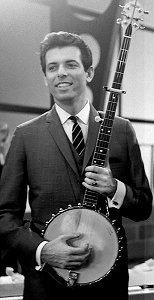 Playing in Odd Keys - I won't go into as much detail on these as I did on the other methods, because almost nobody starts out on these, and by the time folks get one, they've already "learned the ropes" of playing in funky keys with some of the methods above.
Playing in Odd Keys - I won't go into as much detail on these as I did on the other methods, because almost nobody starts out on these, and by the time folks get one, they've already "learned the ropes" of playing in funky keys with some of the methods above.
Also, this is not an instrument for people with short arms! Seeger, who was tall enough, often played it with the pot (body) sticking out past his right hip. Alex Hassilev of the Limeliters (right) held his nearly straight up and down.
Conclusion
As you learned in previous lessons, you can play in keys like G, C, D, and A with only minor retunings. And if you have to play in some really obnoxious key, the capo will take care of four out of five of the strings.If you read very carefully, you'll notice that what you do with the fifth string is very similar, whether you just retune, use a 5th-string capo or use spikes. For example:
- For songs in G and C, you leave the 5th string alone.
- For songs in D and A, you raise the fifth-string to an A, whether you do it by retuning, capoing, or spiking.
- For other songs it helps if you have a fifth-string capo or spikes on your banjo, but it's not critical.
Which do I prefer? When I was a young would-be folksinger in the 1960s, I would have loved a long-neck banjo. At the time I felt it would have made it easier to play some of my favorite styles in more singable keys, as well as playing along more easily with other musicians not addicted to G and C. But in the past forty-odd years, I've figured out a bunch of "workarounds" and added picking styles that wouldn't necessarily benefit all that much from a long-neck anway. So while I would not turn down a nice long-neck if it came my way, it wouldn't exactly change my life at this point.
Between the spikes and the fifth-string capo, I would generally prefer a banjo that is professionally spiked, at least on frets 7, 9, and 10 (although my "best case" is to have 6 and 8 spiked as well). If some national figure had the poor judgment to invite me on a big tour or recording studio gig tomorrow, I'd probably get my best current banjo professionally spiked as soon as possible, just to be on the safe side. But the key word in that sentence is "current." Which banjo I play depends on what kind of music I feel like playing at that time, plus I've been known to "upgrade," then go back to my old one because the expensive features I shelled out for didn't really have the tone I was looking for anyway.
Besides, I do mostly solo work these days, and most of my repertoire is in C, G, A, or D, none of which require modifications to any of my banjos. And I have enough experience that if someone says, "Let's do this in Ab," I can make the adjustment quickly.
So the long anwer is that right now, none of the six banjos currently in my possession, ranging from "beach" to "pro," have long necks, spikes, or 5th-string capos. And none of my few upcoming gigs require those modifications in any way. But next week, that might change. In other words, your mileage will vary. The purpose of this "lesson" was not to promote one approach or another, just to tell you what was available and why some folks prefer certain choices.
If nothing else, get a cheap Jim Dunlop capo for your banjo and please learn the first part of this lesson, so if you get into a situation where you need to play in a goofy key you don't reinforce your guitar-playing acquaintances' stereotype of banjo player in general.
In the meantime please contact us if you have any questions or hit any brick walls.
All material, illustrations, and content of this web site is copyrighted © 2001, 2002, 2003, 2004, 2005, 2006,
2007, 2008, 2009, 2010, 2011, 2012, 2013, 2014, 2015 by Paul D. Race. All rights reserved.
Creek Dont' Rise(tm) is a participant in the Amazon Services LLC Associates Program, an affiliate advertising
program designed to provide a means for sites to earn advertising fees by advertising and linking to Amazon.com.
For questions, comments, suggestions, trouble reports, etc. about this play or about this web page, please contact us.
| Visit related pages and affiliated sites: | ||||||
| - Music - | ||||||

|
 |
 |

|

|

|
|

|

|

|

|

|

|
|
| - Trains and Hobbies - | ||||||
 |

|

|  |
 |

|
|
| - Christmas Memories and Collectibles - | ||||||
 |

|
 |

|
 |

|
|
| - Family Activities and Crafts - | ||||||
 |

|

|

|

|

|
|
